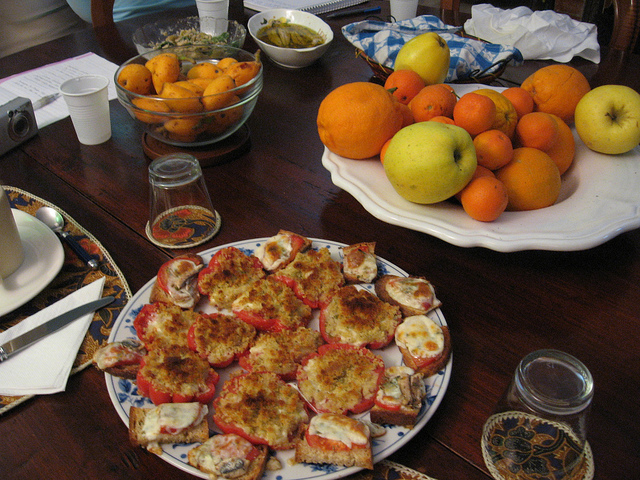My first afternoon and night on a sailboat had gone surprisingly well. After our little late night excursion into the town of Lipari I had slept like a stone, only to awake this morning at about 8 am to see in daylight what the island of Lipari actually looks like. So I peeked my head out of the sailboat and I saw it was an absolutely gorgeous day! Blue, sunny skies, not a cloud to be seen. Perfect for exploring Lipari, the capital of the Eolian island of the same name.
Our skipper was up already while my three other co-travellers were still resting. Francesco and I each grabbed a little snack from our plentiful stash below deck, sat down and enjoyed the gorgeous ambience. We were surrounded by dozens of boats, mostly sailboats, some power boats, and a few of them rather imposing yachts, while towards the land we saw a number of local fishing boats tied up and fishermen straighten out their nets.

View of the sailboat harbour of Lipari
I mentioned to Francesco that the experience on this sailboat and in Sicily in general is so different from our hurried, frenetic pace in our North American urban centres. I added that it was an extremely welcome change from my usual routine. The rhythm of life is definitely slower here, and people appear to have different, simpler priorities: they focus on their friends and family, and eating good food, drinking good wine, and enjoying life, every day. Our skipper himself, authentically Sicilian, also radiated a profound sense of calm and contentedness.

Our skipper Francesco
Around 10 am I was ready to start exploring and started my walk towards downtown Lipari. The half-hour walk along a busy road is very scenic, with mountains on one side and the sea on the other, and the hilltop fortification of the town of Lipari beckoning in the distance. On my way into town I saw a scooter rental place, and at 15 Euros per day I was very tempted to rent one for a couple of hours. Instead I decided to get a bit of exercise and continue my walk into town.

Fishing boats
With about 11,000 residents, Lipari is the largest and most populous island in the 7-island Eolian archipelago. It is an extremely popular tourist destination: during the summer the population swells to over 200,000 people. It is a vibrant commercial centre and active ferry boat harbour. I strolled into town on one of the main streets which was full of retail stores, vegetable and fruit stands and a variety of restaurants.

The municipal offices of Lipari
A fairly steep cobble-stoned street pointed up toward a hill, so I followed it and arrived at the fortification of the town of Lipari which has a long and convoluted history. Inhabited from at least 5000 BC, the island has been ruled by successive waves of Greeks, Carthaginians, Etruscans, Romans, Byzantines, Arabs, Saracens, Normans, Hohenstaufen, Angevins and Aragonese. The imposing city walls were built by the Spanish on top of an ancient Greek acropolis in the mid 1500s. Within the walls of the fortification is an imposing cathedral, an old castle, excavations of an ancient Greek settlement as well as the Museo Archeologico Eoliano.

Archeological zone in Lipari
A long set of steps leads up from the lower level of town to the Cathedral and on a small patch of grass beside the steps an old local man had set up shop to sell a variety of handcrafted doilies as well as volcanic stones such as pumice and obsidian which both occur naturally on this island.

Nonno Dorino and his doilies
I came up to him to see what he had for sale and he introduced himself as “Nonno Dorino” (“Grandpa Dorino”) and told me that he crochets all the doilies himself. Quite charmingly he engaged me in a conversation and I ended up purchasing two of the crocheted masterpieces from him. Along the way he showed me a picture of his granddaughter and gave me free samples of each type of volcanic stone. I always love interactions with the locals, and Nonno Dorino was a real character. He definitely knows how to charm the tourists.

The Cathedral of Lipari




